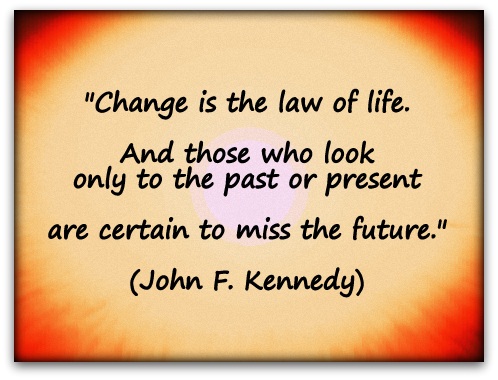Coaching Quote of the Day 25th November 2014

“You must never find time for anything. If you want time you must make it.”
(Charles Buxton)

“You must never find time for anything. If you want time you must make it.”
(Charles Buxton)

“Imaginary troubles are harder to bear than actual ones.”
(Dorothy Dix)

“Theoretically there is a perfect possibility of happiness: believing in the indestructible element in oneself and not striving towards it.”
(Franz Kafka)

“Change is the law of life. And those who look only to the past or present are certain to miss the future.”
(John F. Kennedy)
In this weeks guest post Amy Brann shares some of her expertise on the subject of Neuroscience and coaching

From the perspective of Coaches, neuroscience is the field that can inform them of important things about the brain. Things that are key to new ways that you work with clients and also things that underpin things you are already familiar with. Neuroscience can explain why and how Coaching works. It can enlighten Coaches as to things to pay particular attention to. It can warn against other practices.
We believe an understanding of neuroscience will become expected to underpin everything that sits on top of it. Neuroscience is not claiming to be better than anything a Coach currently does or to replace it. Rather we suggest it will enhance your understanding of those you work with.
What can neuroscience offer the Coaching World?
How does neuroscience relate to other disciplines?
We can think of neuroscience as a friend to other disciplines, such as psychology. Often in academic circles there is cross over and collaboration. In my team we have neuroscientists, psychologists, behaviour analysts and several other experts. In the spirit of full disclosure I’ll share that sometimes we generate a little heat between the neuroscientists and the behaviour guys. Ultimately though we all realise that we can each learn from one another and stimulate deeper research and insights.
When can I use neuroscience with a client?
There are a huge number of opportunities within a normal Coaching engagement to use neuroscience to guide us. Here are just a few, many of which take on new depth and significance when you understand the neuroscience (remembering some words have slightly different psychological or neuroscientific meaning to in normal Coaching usage, e.g. reward):
| Coaching Opportunity | Example of Areas / studies in Neuroscience | Example of applications |
| Connecting with client | Trust and fairness and oxytocin | Actively finding ways to build trust with your client and demonstrate your fairness |
| Goal setting | Decision making, visualisation, willpower | Citing a visualisation study to help a client see the potential value |
| Examining their environment | Nudging and priming | Explore your client’s normal environment and where they are when they need to do behaviours leading to goal attainment |
| Behavioural evaluation | Hot & Cold network | Your client’s behaviour is key to their results and is influenced by many factors. |
| Rewards | Dopamine | Helping your client understand what is currently activating their reward circuitry can be empowering and important in making changes |
| Habits analysis | Hebbs Law, Basal Ganglia | Being clear on how new habits are formed |
From the perspective of the Coach it makes sense to immerse oneself in all areas of study that can help us understand better how people’s minds and brains work.
If you’ve enjoyed this article, I invite you to visit Amy’s website, and become a member of her free and insightful Neuroscience for Coaches community, so that you can further experience the impact of applying neuroscience insights on your life and career! Understanding how the brain works gives you a competitive advantage over Coaches who do not. As a welcome gift, you will receive a special complimentary resources bundles that includes the 1st chapter of ‘Neuroscience for Coaches’, your Neuroscience for Coaches checklist, and your Neuroscience for Coaches Insights ebook.
Twitter: https://twitter.com/Amy_Brann
LinkedIn: https://www.linkedin.com/in/amybrann

“It’s not what you look at that matters, it’s what you see.”
(Henry David Thoreau)

Each Thursday I share the most RT’d quote(s) from the blogs twitter account over the previous week.
Last week the most RT’d tweet was:
“The reason most major goals are not achieved is that we spend our time doing second things first.”
(Robert J. McKain)
Tweeted on 15th November
The quote with the next highest amount of RT’s was a tie between:
“You cannot dream yourself into a character; you must hammer and forge yourself one.”
(James A.Froude)
Tweeted on 15th November
and
“Life is a succession of lessons which must be lived to be understood.”
(Ralph Waldo Emerson)
Tweeted on 12th November

Many thanks to everyone who shared the quotes above and the other quotes from last week. I know that there are various aspects that can influence if a quote attracts your attention – if you saw the tweet, personal style, if it speaks to something happening in your life at that moment etc.

(For those of you as geeky as I am and wondering what tool I’m using to measure individual RT’s this week I’ve been playing with www.twitonomy.com)

“Life is like a trumpet – if you don’t put anything into it, you don’t get anything out of it.”
(William Christopher Handy)